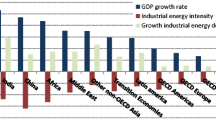Abstract
The industry sector accounts for more than a third of global final energy consumption and nearly the same share of global energy-related CO2 emissions. Compared with other sectors, however, industrial energy modelling has received less attention due to the variety of sub-sectors, impact of energy-saving measures on product qualities and statistical problems. This paper explains how the industry sector is modelled in the World Energy Outlook and presents energy-saving opportunities from energy efficiency in the sector. Using the World Energy Model, a partial equilibrium model, it is found that exploiting the economic potential of energy efficiency can reduce energy demand growth in industry from 1.5 to 1.1 % per year on average over the period 2010–2035. Savings arise from faster adoption of more efficient technologies, phasing out older facilities, process change and system optimisation, including electric motor-driven systems. Significant barriers to the implementation of energy efficiency are the requirement for short payback periods and concerns that change could interrupt production or affect reliability. In order to realise the potential energy savings, policy makers need to address these issues by improving mechanisms for capacity building, energy management and financing.







Similar content being viewed by others
Notes
This section is largely based on the model documentation of the World Energy Model (IEA 2013a).
The Hodrick-Prescott filter separates the cyclical component of a time series from the underlying trend.
CO2 emissions savings from energy efficiency alone are not enough in terms of contribution from the industry sector to limit the global temperature increase to 2 °C, but need to be complemented by the use of low-carbon energy and carbon capture and storage (CCS).
References
Akashi, O., Hanaoka, T., Matsuoka, Y., & Kainuma, M. (2011). A projection for global CO2 emissions from the industrial sector through 2030 based on activity level and technology changes. Energy, 36, 1855–1867.
CSI and ECRA. (2009). Development of state of the art-techniques in cement manufacturing: trying to look ahead. Düsseldorf, Geneva: CSI/ECRA.
Fleiter, T., Fehrenbach, D., Worrell, E., & Eichhammer, W. (2012). Energy efficiency in the German pulp and paper industry—a model-based assessment of saving potentials. Energy, 40, 84–89.
Fleiter, T., Worrell, E., & Eichhammer, W. (2011). Barriers to energy efficiency in industrial bottom-up energy demand models—a review. Renewable and Sustainable Energy Reviews, 15, 3099–3111.
Gielen, D., & Taylor, M. (2007). Modelling industrial energy use: The IEAs Energy Technology Perspectives. Energy Economics, 29(4), 889–912.
Greening, L. A., Boyd, G., & Roop, J. M. (2007). Modeling of industrial energy consumption: an introduction and context. Energy Economics, 29, 599–608.
Hasanbeigi, A., Morrow, W., Sthaye, J., Masanet, E., & Xu, T. (2013). A bottom-up model to estimate the energy efficiency improvement and CO2 emission reduction ptoentials in the Chinese iron and steel industry. Energy, 50, 315–325.
IEA. (2003). Energy balances of non-OECD countries 2003. Paris: OECD/IEA.
IEA. (2010). Energy Technology Perspectives. Paris: OECD/IEA.
IEA. (2011). Energy-efficiency policy opportunities for electric motor-driven systems. Paris: OECD/IEA.
IEA. (2012a). Energy Technology Perspectives 2012. Paris: OECD/IEA.
IEA. (2012b). World Energy Outlook. Paris: OECD/IEA.
IEA. (2013a). World Energy Model Documentation—2013 version. Paris: OECD/IEA.
IEA. (2013b). Energy balances of OECD countries 2013. Paris: OECD/IEA.
IEA. (2013c). Energy balances of Non-OECD countries 2013. Paris: OECD/IEA.
IEA. (2013d). CO 2 emissions from fuel combustion 2013. Paris: OECD/IEA.
IIP. (2012). Insights into industrial energy efficiency policy packages—sharing best practices from six countries. Washington D.C: Institute for Industrial Productivity.
Jaffe, A. B., & Stavins, R. N. (1994). The energy paradox and the diffusion of conservation technology. Resource and Energy Economics, 16, 91–122.
Ke, J., Zhang, N., Fridley, D., Price, L., & Zhou, N. (2012). Potential energy savings and CO2 emissions reduction of China’s cement industry. Energy Policy, 45, 739–751.
Kuder, R., & Blesl, M. (2010). Technology orientated analysis of emission reduction potentials in the industrial sector in the EU-27. Stockholm: International Energy Workshop.
Morrow, W. R., Hasanbeigi, A., Sathaye, J., & Xu, T. (2012). Assessment of energy efficiency improvement and CO 2 emission reduction potentials in India’s cement industry. Berkeley: Lawrence Berkeley National Laboratory.
Murphy, R., Rivers, N., & Jaccard, M. (2007). Hybrid modelling of industrial energy consumption and greenhouse gas emissions with an application to Canada. Energy Economics, 29, 826–846.
Pardo, N., & Moya, J. A. (2013). Prospective scenarios on energy efficiency and CO2 emissions in the European iron and Steel industry. Energy, 54, 113–128.
Saygin, D., Patel, M. K., Worrell, E., Tam, C., & Gielen, D. J. (2011). Potential of best practice technology to improve energy efficiency in the global chemical and petrochemical sector. Energy, 36(9), 5779–5790.
Saygin, D., van den Broek, M., Ramirez, A., Patel, M. K., & Worrell, E. (2013). Modelling the future CO2 abatement potentials of energy efficiency and CCS: the case of the Dutch industry. International Journal of Greenhouse Gas Control, 18, 23–37.
UNIDO. (2010). Global industrial energy efficiency benchmarking. Vienna: United Nations Industrial Development Organization.
UNIDO. (2011). Barriers to industrial energy efficiency: a literature review. Vienna: United Nations Industrial Development Organization.
UNPD. (2011). World population prospects: the 2010 revision. New York: UNPD.
World Steel Association. (2012). World steel in figures 2011. Brussels.
Worrell, E., Bernstein, L., Roy, J., Price, L., & Harnisch, J. (2009). Industrial energy efficiency and climate change mitigation. Energy Efficiency, 2, 109–123.
Worrell, E., & Price, L. (2001). Policy scenarios for energy efficiency improvement in industry. Energy Policy, 29, 1223–1241.
Author information
Authors and Affiliations
Corresponding author
Rights and permissions
About this article
Cite this article
Kesicki, F., Yanagisawa, A. Modelling the potential for industrial energy efficiency in IEA’s World Energy Outlook. Energy Efficiency 8, 155–169 (2015). https://doi.org/10.1007/s12053-014-9273-7
Received:
Accepted:
Published:
Issue Date:
DOI: https://doi.org/10.1007/s12053-014-9273-7




